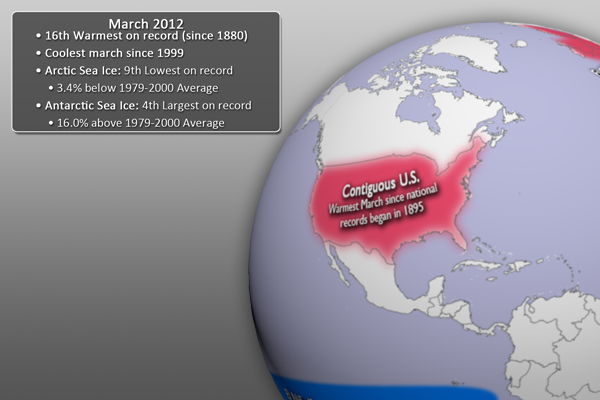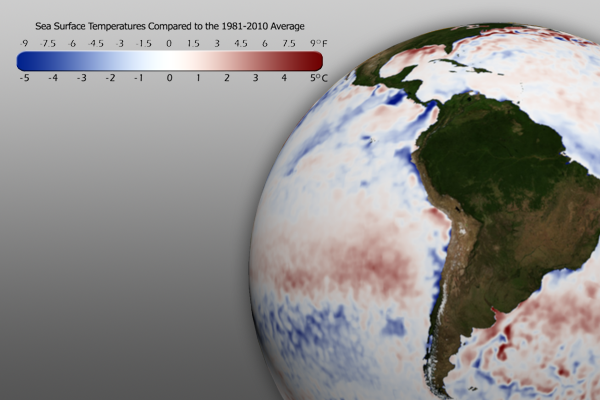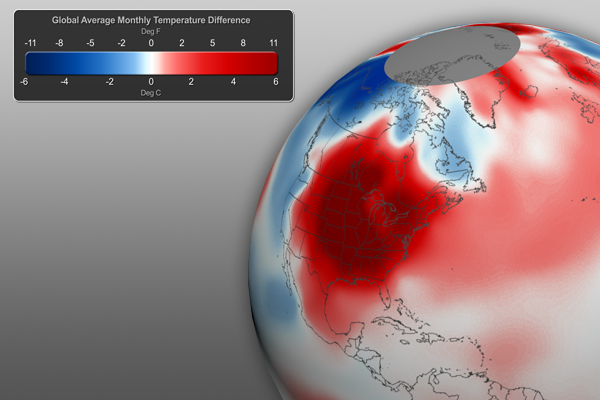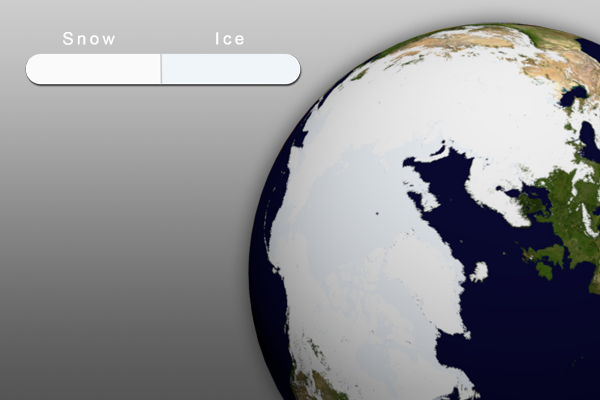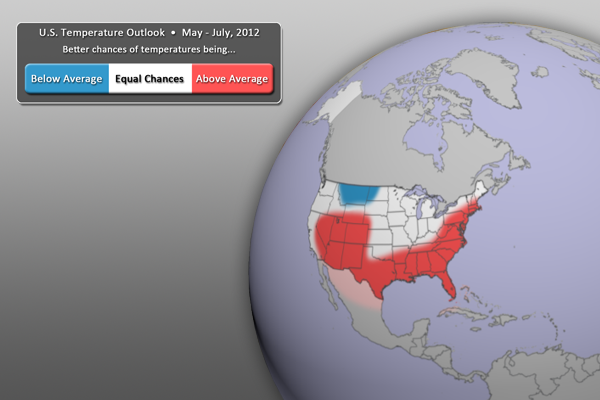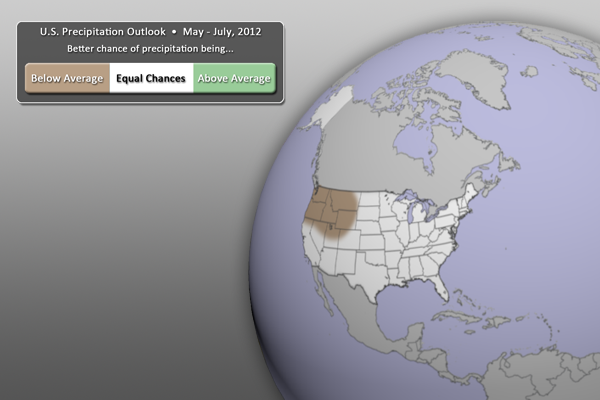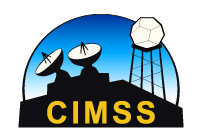Each month, around the middle of the month, we will provide information regarding the previous month’s climate, as well as the U.S. seasonal outlook for the coming months. Overall, preliminary data analysis suggests that March 2012 was the 16th warmest March on record (since 1880). Interestingly, it was also the coolest March since 1999. Major stories include a warm contiguous United States and Europe and weakened La Niña. More detailed information follows:
**Note: We’re trying out something new this time around! If you click on the March 2012 Highlights graphic below, you should have a video version of the dataset start playing. Hopefully, this will allow you better visualize what this will look like on a Science On a Sphere. Let us know what you think.**
March 2012 Highlights
- This dataset shows some of the major March climate highlights from the National Climatic Data Center’s (NCDC) monthly global climate analysis. The events are noted below with more information.
- El Niño/Southern Oscillation (ENSO): The cooler than average waters in the eastern central Pacific Ocean have continued to moderate, signaling a very weak La Niña. ENSO is expected to become “neutral” by May 2012. Click here for more information about La Niña and how it may impact the climate outlook for the coming months.
- United States (contiguous): Most of the country experiences record breaking, or near record breaking temperatures (maximums and minimums). This led to the warmest March since national records began in 1895.
- Europe: After a bitterly cold January and February, much of Europe experienced unusually warm temperatures, including the warmest March on record for Norway. The United Kingdom, Austria, and Germany all had their third warmest March, while Denmark experienced its fourth warmest March.
- Australia: Australia experienced its fourth wettest March in the nation’s 113-year record.
Sea Surface Temperature Anomaly
- The real-time sea surface temperature anomaly dataset is a great way to visualize moderating water temperatures in the eastern central Pacific ocean. This indicates the weakening La Niña pattern mentioned above.
- Remember that the blues indicate cooler than average temperatures and reds indicate warmer than average temperatures (white: average).
Global Temperature Anomalies
- Using the real-time Monthly Temperature Anomalies dataset is a great way to convey where some of the warmer and cooler than average areas were in March.
- The combined global land and ocean average surface temperature for March 2012 was the 16th warmest on record (and coolest since 1999) at 13.16˚C (55.73˚F), which is 0.46˚C (0.83˚F) above the 20th century average.
- It should be noted that “March 2012 marks the 36th consecutive March and 325th consecutive month with a global temperature above the 20th century average. The last March with below-average temperature was March 1976 and the last month with below-average temperature was February 1985.” [NCDC]
Snow and Ice…
- Aside from helping to illustrate seasonal changes, the real-time Snow and Ice Cover dataset is a great way to convey sea ice change through time, including discussing how the current sea ice extent compares to other noteworthy years.
- The Arctic sea ice extent in February was the ninth lowest on record. The extent was 3.4% below the 1979-2000 average.
- In Antarctica, the January sea ice extent was the 4th largest on record, at 16.0% above the 1979-2000 average.
U.S. Temperature Outlook
- Weakening La Niña conditions are expected to influence the U.S. temperature outlook (see below).
- For the May – July period, warmer than normal temperatures are expected across much of the southern part of the country, up along the east coast, and into the four corners region.
- By contrast, cooler than normal temperatures can be expected for Montana and the areas surrounding that state.
- All other locations (in white) have equal chances of being warmer or cooler than normal.
- Outlook by NOAA’s Climate Prediction Center (CPC)
- In its forecasts, the CPC uses a wide variety of models in conjunction with looking at climate variables (like La Niña).
- It should be noted that areas in the “warmer than normal” region may still have cold winter days. This outlook only suggests that after the three months (April, May, and June) are over, those areas in the “warmer than normal” region are more likely to have experienced warmer than normal average temperatures. The same is true for the “cooler than normal” and “equal chances” regions.
U.S. Precipitation Outlook
- For the next three months (May – July), drier than normal conditions are expected for the Pacific Northwest, reaching as far east as Wyoming and Montana.
- Wetter than normal conditions are not expected anywhere.
- All other locations (in white) have equal chances of being wetter or drier than normal.
- Outlook by NOAA’s Climate Prediction Center (CPC)
- In its forecasts, the CPC uses a wide variety of models in conjunction with looking at climate variables (like La Niña).
- It should be noted that areas be in the “drier than normal” region may still have rain and snow storms. This outlook only suggests that after the three months (April, May, and June) are over, those areas in the “drier than normal” region are more likely to have experienced drier than normal averages. The same is true for the “wetter than normal” and “equal chances” regions.
Helpful Resources for More Information
- http://www.ncdc.noaa.gov/oa/ncdc.html National Climatic Data Center (NCDC)
- http://www.ncdc.noaa.gov/teleconnections/enso/enso-tech.php About ENSO (El Niño/La Niña)
- http://www.ncdc.noaa.gov/sotc/global/ NCDC’s Global Climate Report
- http://www.pmel.noaa.gov/tao/elnino/la-nina-story.html About La Niña
- http://www.cpc.ncep.noaa.gov/ Climate Prediction Center (CPC)
- http://nsidc.org/arcticmet/patterns/arctic_oscillation.html About AO (Arctic Oscillation)
Where do I find the datasets?
- First, check your SOS system to make sure it’s not already in the EarthNow category. There should also be an ‘earthnow.sos’ playlist file (you’ll need to add that to your sosrc folder).
- If not, you can download the datasets and playlist.sos files from this FTP Site.

